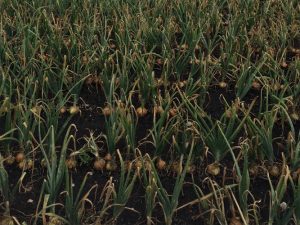What Is It? | Facts in Depth | For the Professional Diagnostician
Garlic & Onion Diseases | Onion Anthracnose
Onion Anthracnose
Identification
Bulb Symptoms
- Lesions formed in concentric rings (approximately 1 cm in diameter) on the bulb
- Salmon- to cream-colored masses in lesions
- Colletotrichum circinans usually first attacks the bulbs



Foliar Symptoms
- Salmon- to cream-colored masses observed in the lesions on the neck and leaves of the onion plants
- Yellow halos may appear around the lesions
- Curling, twisting, or distortion of the leaves
- Yellowing, chlorosis, and death of leaves
- In severe cases, dieback and neck elongation can also be observed
- Colletotrichum gloeosporioides and coccodes have been reported to infect mainly leaves and neck, which is different from C. circinans.



Favorable Environmental Conditions
- High humidity and 12+ hours of continuous wetness aid in disease progression
- Spore germination occurs at 55°F – 77°F
- Disease development at 55°F – 90°F.
- At 82°F, conidia germinate.
Often Confused With
- Onion smut
- Purple blotch
Scouting Notes
- Periodically monitor for yellowing, curling, twisting, chlorosis, or death after periods of warm/hot temperatures with high humidity or continuous wetness.
- Salmon- to cream-colored masses in lesions are an indication of onion anthracnose.

